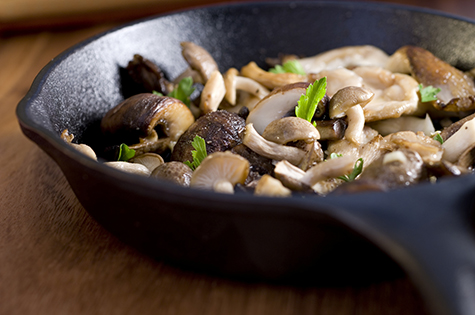Miraculous Mushrooms Are a Food Powerhouse

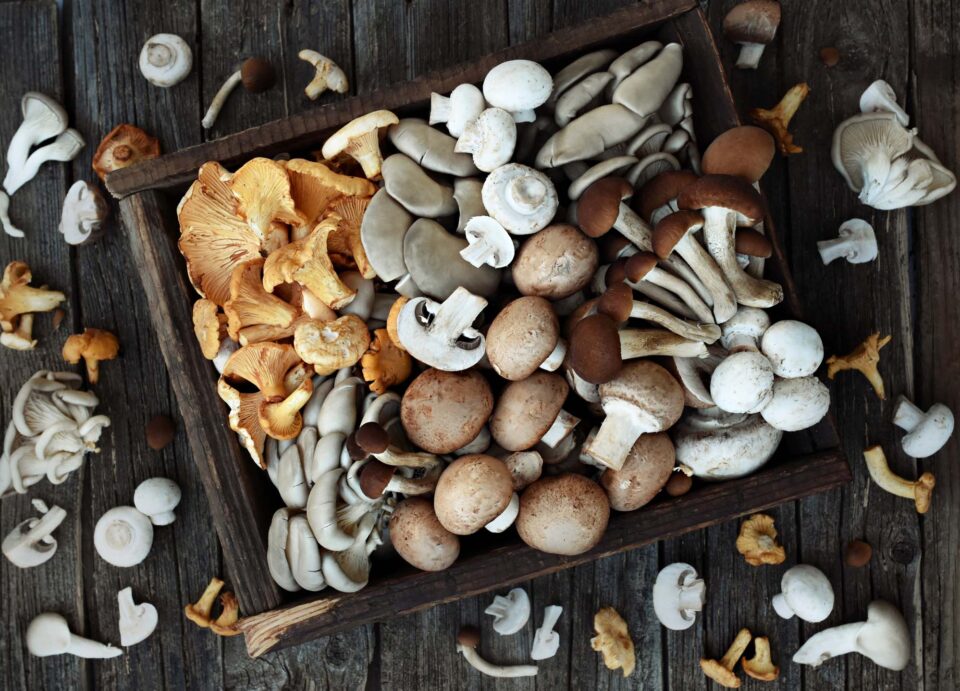
Most of the people I know have very strong feelings about mushrooms—they either love them or hate them. One of the beauties of mushrooms is that they usually take on the flavor of whatever they are cooked with. If it’s garlic and olive oil, that’s what they taste like. If they’re in a spicy Asian stir fry, they take on those flavors. One thing is certain — mushrooms are healthy little powerhouses of immunity boosters, antioxidants, vitamins and minerals. Rich in B vitamins such as riboflavin, folate, thiamine, pantothenic acid, and niacin, they are also the only vegan, non-fortified dietary source of vitamin D. Mushrooms also provide several minerals that may be difficult to obtain in the diet, such as selenium, potassium, copper, iron, and phosphorus.
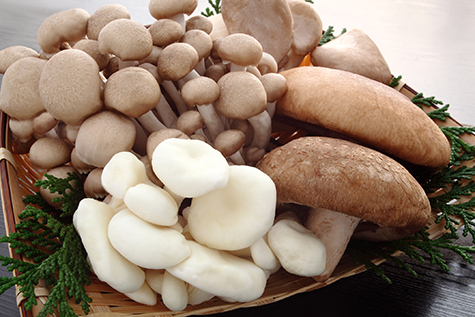 With just 45 calories per cup, you can afford to indulge in these versatile fungi. I prefer fresh mushrooms and use organic ones whenever I can find them. In my cookbook – The AGE BEAUTIFULLY cookbook, I’ve included a number of recipes with mushrooms, including my Wild Rice and Quinoa Salad. Check out recipes for my Mushroom Medley and Shirataki Noodle Salad below.
With just 45 calories per cup, you can afford to indulge in these versatile fungi. I prefer fresh mushrooms and use organic ones whenever I can find them. In my cookbook – The AGE BEAUTIFULLY cookbook, I’ve included a number of recipes with mushrooms, including my Wild Rice and Quinoa Salad. Check out recipes for my Mushroom Medley and Shirataki Noodle Salad below.
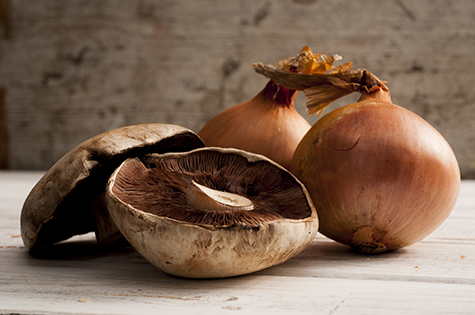 Not long ago at the Natural Products Expo, which is held every year in Anaheim, CA, I attended a presentation by Paul Stamets, the noted mycologist (mushroom and fungi expert). He is passionate about mushrooms because he sees them as “improving the health of the population and the planet using natural means.” The premise of his very interesting book, Mycelium Running: How Mushrooms Can Help Save the World is that the soil contains vast networks of mycelium, the vegetative part of a fungus. It’s all pretty technical, but basically through the mycelium, a fungus absorbs nutrients from its environment in a two-stage process: First, by secreting enzymes onto a food source, such as a fallen tree or other dead plants, which breaks it down. Then, the resulting molecules and nutrients are absorbed into the mycelium and enrich the soil.
Not long ago at the Natural Products Expo, which is held every year in Anaheim, CA, I attended a presentation by Paul Stamets, the noted mycologist (mushroom and fungi expert). He is passionate about mushrooms because he sees them as “improving the health of the population and the planet using natural means.” The premise of his very interesting book, Mycelium Running: How Mushrooms Can Help Save the World is that the soil contains vast networks of mycelium, the vegetative part of a fungus. It’s all pretty technical, but basically through the mycelium, a fungus absorbs nutrients from its environment in a two-stage process: First, by secreting enzymes onto a food source, such as a fallen tree or other dead plants, which breaks it down. Then, the resulting molecules and nutrients are absorbed into the mycelium and enrich the soil.
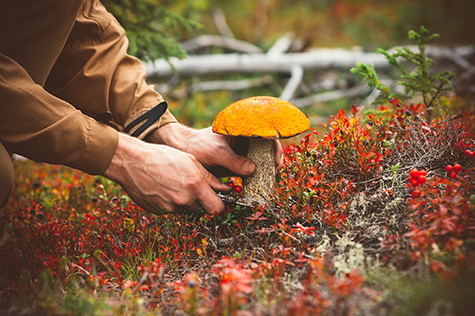 As a defense against bacterial invasion, fungi have developed strong antibiotics, which also happen to be effective for us humans. Penicillin, streptomycin, and tetracycline all come from fungal extracts. Mushrooms, which thrive on decaying organic material, are able to absorb nutrients and safely eliminate toxins.
As a defense against bacterial invasion, fungi have developed strong antibiotics, which also happen to be effective for us humans. Penicillin, streptomycin, and tetracycline all come from fungal extracts. Mushrooms, which thrive on decaying organic material, are able to absorb nutrients and safely eliminate toxins.
Here’s more on what mushrooms can do for us. They can:
- Improve immune system function – Mushrooms are rich in protein, fiber, vitamin C, B vitamins, calcium
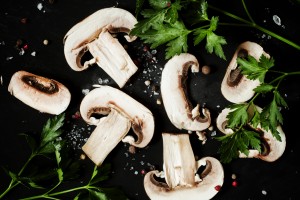 , and minerals. There are about 50 species of medicinal mushrooms that are so rich in antioxidants they can do everything from boost your
, and minerals. There are about 50 species of medicinal mushrooms that are so rich in antioxidants they can do everything from boost your - immune function to lower your risk of cancer, heart disease, and allergies. The alpha and beta glucan molecules present in mushrooms play a major role in their beneficial effects.
- Increase vitamin D levels – Consuming dried white button mushroom extract was found to be as effective as taking supplemental vitamin D2 or D3. Interestingly, Stamets’ book cites a study in which shitake mushrooms increased in vitamin D from 110 IUs when they were dried indoors to 21,400 IUs when they were dried in the sunlight. D vitamins are essential for the body to absorb calcium and maintain bone health.
- Help weight loss –Mushrooms increase enzymes with antioxidant activity. Studies show they can be metabolic enhancers, stimulating the breakdown of sugar in blood cells. Replacing a beef patty with a hearty Portobello mushroom eliminates over 100 calories.
Not all edible mushrooms are good to eat. Some such as turkey tail or maitake (hen of the woods) are highly beneficial, but only readily available as dietary supplements. Our FoodTrients supplement authority, Ginger Hultin, MS, RDN, LDN, has written articles on the benefits of reishi and turkey tail mushrooms supplements if you would like to learn more about them.
Mushrooms for the Immune System is the first article in a series by Ginger Hultin, MS, RDN, LDN. Part 1 lists the Top 5 Medicinal Mushrooms for the Immune System and Part 2 lists the The Top 5 Medicinal Mushrooms To Fight Cancer.
Meanwhile, here are a number of delicious mushroom varieties that you can find fresh in the produce section of your local supermarket or online in dried form:
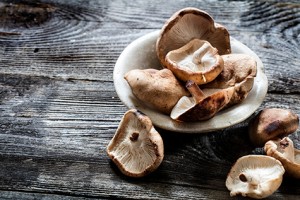 Shiitake – One of the most widely cultivated and most tasty. Contains a chemical called lentinan, approved as an injectable drug in Japan to help prevent damage from anti-cancer drugs. Helps increase activity of T-cells which stimulates the immune system. The theory is that, because they are fungus, they trick the immune system into thinking it’s under attack. Japanese studies suggest consumption of shiitakes lowers blood cholesterol by 45% due to an ingredient called eritadenine. These are commonly found in supermarket produce departments.
Shiitake – One of the most widely cultivated and most tasty. Contains a chemical called lentinan, approved as an injectable drug in Japan to help prevent damage from anti-cancer drugs. Helps increase activity of T-cells which stimulates the immune system. The theory is that, because they are fungus, they trick the immune system into thinking it’s under attack. Japanese studies suggest consumption of shiitakes lowers blood cholesterol by 45% due to an ingredient called eritadenine. These are commonly found in supermarket produce departments.
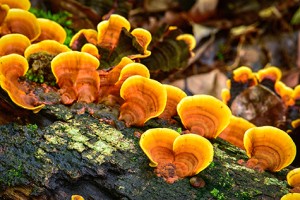 Reishi – In traditional Chinese medicine, reishi mushrooms are considered to have many health and curative properties. The Sloan-Kettering Cancer Center website suggests that reishi extract stimulates the immune system. The site also states that there have been clinical studies indicating that it increases antioxidant capacity and enhances immune responses in advanced-stage cancer patients. Reishis are natural stress reducers—helpful to those under physical and emotional stress. You can find them online in dried form. (To learn more about the benefits of Reishi mushrooms, read nutritionist Ginger Hultin’s article.)
Reishi – In traditional Chinese medicine, reishi mushrooms are considered to have many health and curative properties. The Sloan-Kettering Cancer Center website suggests that reishi extract stimulates the immune system. The site also states that there have been clinical studies indicating that it increases antioxidant capacity and enhances immune responses in advanced-stage cancer patients. Reishis are natural stress reducers—helpful to those under physical and emotional stress. You can find them online in dried form. (To learn more about the benefits of Reishi mushrooms, read nutritionist Ginger Hultin’s article.)
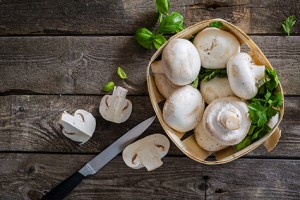 Cremini – These are the common white button mushrooms. According to Regina Wilshire, N.D., a 5 oz. serving contains 50% of RDA for cancer-fighting trace mineral selenium, 40% of RDA riboflavin, 35% of copper, 30% of niacin, 20-25% of pantothenic acid, phosphorous, zinc, plus 10-15% of manganese and thiamin. These are readily available fresh in stores.
Cremini – These are the common white button mushrooms. According to Regina Wilshire, N.D., a 5 oz. serving contains 50% of RDA for cancer-fighting trace mineral selenium, 40% of RDA riboflavin, 35% of copper, 30% of niacin, 20-25% of pantothenic acid, phosphorous, zinc, plus 10-15% of manganese and thiamin. These are readily available fresh in stores.
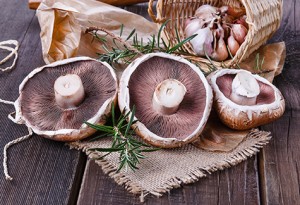 Portobello – These are the mature cremini mushrooms. They have a meaty texture and an intense, earthy flavor. They are low in calories and high in pantothenic acid, niacin, folate, thiamin and B vitamins, which are important for a healthy metabolism, skin, liver and hair. Portobello mushrooms are in most produce departments.
Portobello – These are the mature cremini mushrooms. They have a meaty texture and an intense, earthy flavor. They are low in calories and high in pantothenic acid, niacin, folate, thiamin and B vitamins, which are important for a healthy metabolism, skin, liver and hair. Portobello mushrooms are in most produce departments.
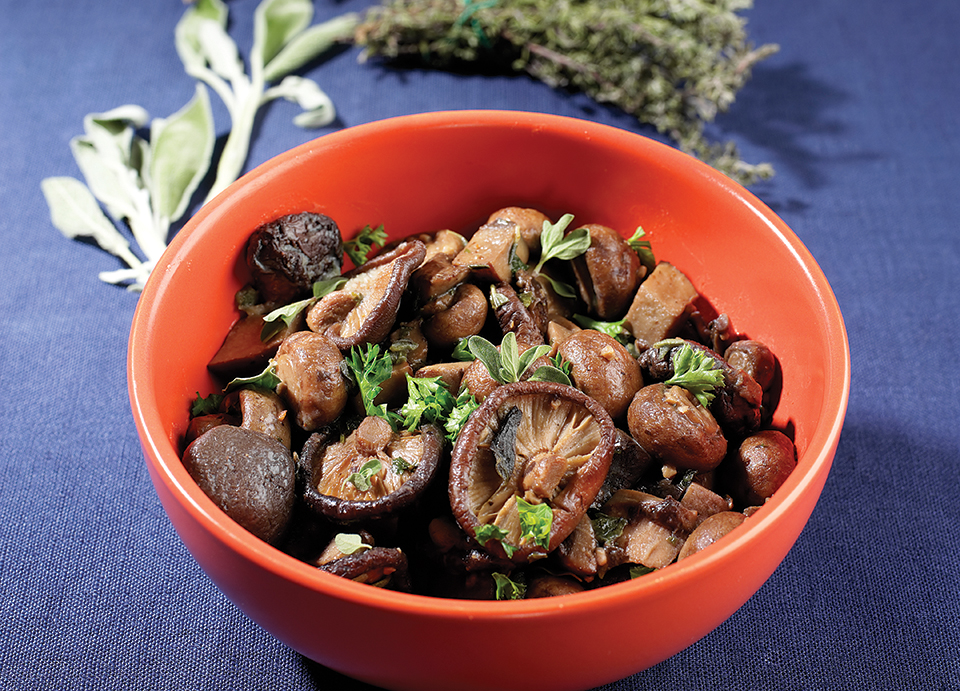 Mushroom Medley
Mushroom Medley
Serves 2–4
Mushrooms detoxify the soil they grow in. This side dish pairs well with chicken or beef or game meats. You can use almost any variety of mushrooms in any combination. I leave the small mushrooms whole because they look nicer that way, but you can chop them if you prefer.
The Benefits: Mushrooms contain selenium, an antioxidant that boosts immune function and reduces cancer risk. Beta glucans in mushrooms boost the immune system. Mushrooms are also a good source of vitamin D, for strong bones.
Chef’s Note
If you use dried mushrooms, first hydrate them in boiling-hot water for at least 20 minutes, then drain well before braising in butter.
Ingredients
1 cup shiitake mushrooms
1 cup white button mushrooms
1 cup chopped Portobello mushrooms
1 cup cremini mushrooms
3 Tbs. butter
1 tsp. minced garlic
1 Tbs. balsamic vinegar
1 tsp. chopped fresh parsley
1 tsp. fresh oregano
1 tsp. fresh thyme
1 tsp. fresh marjoram
¼ sea salt or salt substitute
¼ tsp. black pepper
Procedure
- In a heavy enamel-covered pan, braise the mushrooms in the butter and garlic over low or medium-low heat for 10–15 minutes, stirring often, or until the mushrooms shrink and darken all the way through.
- Add the balsamic vinegar, herbs, salt, and pepper, and cook for another 5–10 minutes or until the liquid around the mushrooms has thickened a bit.
Shirat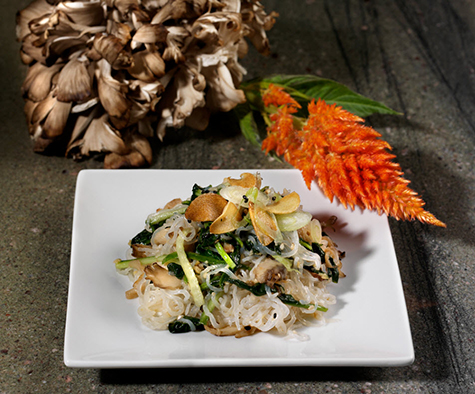 aki Noodle Salad
aki Noodle Salad
Serves 2–4
Shirataki noodles are very popular. Made from yam fiber, these thin, white, gluten-free noodles are sold water- or vacuum-packed. Because they have almost no flavor of their own, they must be served with sauce in order to be enjoyed. I created this salad with spinach and maitake mushrooms, also called hen-of-the-woods mushrooms because of their roughly, henlike appearance.
The Benefits: Shirataki noodles contain plenty of fiber to fill you up without adding calories or carbohydrates. Spinach offers lutein for eye health. Ginger and garlic are natural anti-inflammatories. Maitake mushrooms have beta glucan, which may fight cancer cells and slow tumor growth. All mushrooms contain selenium, which lowers cancer risk and boosts immune response.
Chef’s Note: If you use dried mushrooms instead of fresh, rehydrate them first in hot water for 20 minutes. You can use soba noodles in the same quantity as the shirataki noodles, but you will be adding calories and carbohydrates.
INGREDIENTS
7–8 oz. shirataki noodles
3 Tbsp. sesame oil
1 Tbsp. chopped garlic
1 tsp. peeled and chopped ginger
½ cup chopped maitake (or morel, chanterelle, or oyster) mushrooms
2 cups whole baby spinach leaves
4 cloves thinly sliced garlic
¼ cup julienned Persian cucumbers, as garnish
1–2 tsp. toasted sesame seeds, as garnish
1 Tbsp. thinly sliced scallions, as garnish
DRESSING
½ cup seasoned rice vinegar
1 Tbsp. sesame oil
1–2 Tbsp. maple syrup or all-natural brown sugar
1 tsp. sea salt
Dash of white pepper
PROCEDURE
- Blanch the shirataki noodles in boiling water for 1 minute. Drain and pat dry.
- Make the salad dressing: Combine the dressing ingredients in a jar, close the lid tightly, and shake well.
- Cook the vegetables: In a sauté pan, warm 1 Tbs. of the oil over medium heat. Add the garlic and ginger and cook for 1–2 minutes. Add the mushrooms and cook for 3–5 minutes. Add the spinach and cook for 1–2 minutes or until the spinach has fully wilted. Cool the vegetables in the refrigerator.
- In a cold pan, toast the garlic in the remaining oil. Reduce the heat to low and allow to slowly crisp and lightly brown. Set aside to cool.
- To assemble: Toss the noodles in a bowl with half the dressing. Add the vegetables, toss, then the garnishes, and toss. Serve with the remaining dressing on the side, if desired, or store in the refrigerator up to 2 weeks.
